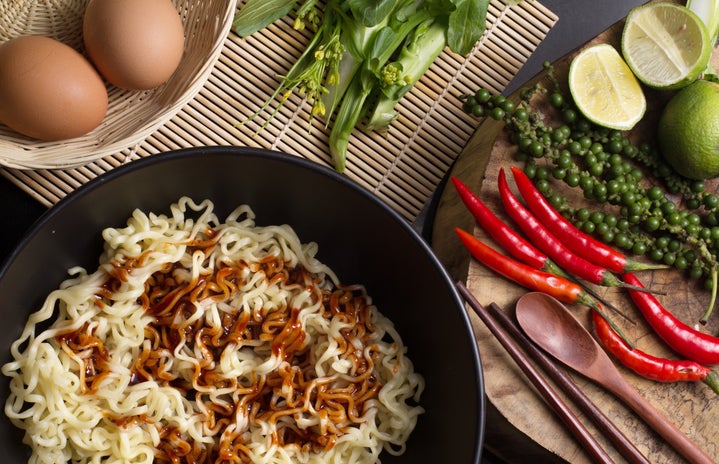Ramen is a staple for many struggling college students’ diets, dare I call it the staple. It’s fast, it’s cheap, and it doesn’t come at the devastating cost of a million dirty dishes left over.
With that said, it’s 2023 now. If you’re simply tossing the regular old 25-cent ramen in some water with a seasoning packet, it’s time to expand your mindset and greatly enhance a simple meal with a few extra ingredients to hit more of the food groups.
Traditional ramen is a Japanese dish consisting of Chinese-style noodles served in a broth with various toppings. While the Americanized instant ramen is a bit of a deviation from the classic, here are my tips and tricks to elevate your college dorm ramen experience.
The first thing we need to cover is the kind of ramen you’re cooking. While generic ramen is great in a pinch, there’s an entire world of instant ramen waiting to be discovered. My favorite brands are Shin Ramyun and Samyang Buldak, two of the most popular international ramen brands. These cost a little more, but offer an amazing experience in terms of rich flavor and often come with veggie packs to add.
Now, both of these are considerably spicier than Top Ramen, but don’t worry. A great trick to cut the spice down is to boil the noodles in milk rather than water— sounds odd, but the end result is creamy and delicious without singeing your mouth off with each bite. Another great hack is to melt some cheese into the broth. This’ll thicken it up a bit, giving a beautiful cheese pull with each bite.
Another way to lower the spice a little and get some extra protein in is to temper an egg into the broth. This is done by whisking an egg in a separate, heat-safe bowl while your noodles cook. After the noodles are done, slowly pour some of the boiling water into the egg mixture and vigorously stir. For those who don’t love the taste of eggs, tempering them as a great way to still get some protein without the egg overwhelming the dish.
Speaking of eggs, there are many different ways they can be prepared in ramen for those who enjoy them. One method is to crack the egg into the pot the noodles are boiling in. If you stir rapidly, the egg will cook in little strands, much like egg-drop soup! If you leave the egg alone while the noodles cook, it’ll poach the egg. Other people prefer to soft boil their eggs before adding them, but that’s a little too much work for this guide— though still delicious if you have the time!
Once your noodles are cooked, it’s time to start really putting our ultimate ramen together. Adding sesame oil gives the broth a nuttier taste, and chili oil can give it an extra kick if you really enjoy spice! Measuring with the heart, I usually add around a tablespoon of sesame oil and a teaspoon of chili oil to my ramen. In addition to these, I also melt a spoonful of peanut butter and add it to the noodles, giving some extra protein and making the broth creamier. May sound odd, but don’t knock it till you try it!
Moving on to vegetables, green onions are a ramen staple. Another fun add-on is enoki mushrooms; these small fungi offer a different texture to the ramen along with a great source of fiber and protein to help regulate your immune system. Other popular additions to ramen include corn, carrots, or bok choy!
Thinking of ramen as the Subway sandwich of soups opens the door to amazing and more nutritious possibilities. If you’re still making plain noodles and broth, it’s time to start experimenting to turn the classic five-minute meal into a five-star meal!


